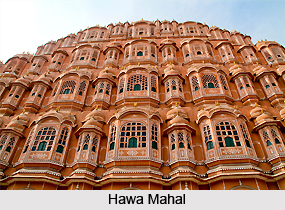Jaipur - Pink City
 Jaipur, also known as the Pink City, is the capital of Rajasthan state in India. In the history of Jaipur, the city is rendered as Jeypore or the former capital of the princely state of Jaipur. Maharaja Sawai Jai Singh, the ruler of Amber founded Jaipur in 1727 and today the city has a population of more than 5 million residents. A recent international survey shows that Jaipur is ranked as the 7th best place to visit in Asia and in another poll it was ranked third among twelve major Indian cities.
Jaipur, also known as the Pink City, is the capital of Rajasthan state in India. In the history of Jaipur, the city is rendered as Jeypore or the former capital of the princely state of Jaipur. Maharaja Sawai Jai Singh, the ruler of Amber founded Jaipur in 1727 and today the city has a population of more than 5 million residents. A recent international survey shows that Jaipur is ranked as the 7th best place to visit in Asia and in another poll it was ranked third among twelve major Indian cities.
In the year 1727, Maharaja Jai Singh laid the foundation of this city. Being one of the most popular Kachhwaha Kings, he reigned from the years 1699 to 1744. The ruler became very enthusiastic at the time of designing this city. He wanted the city to look at its best - planned and systematic from every aspect. He himself was technically sound and artistic in nature; he also consulted Vidyadhar Bhattacharya to design the architecture of Jaipur city. The battles fought by the kings of Jaipur have contributed largely to the history of this city. The Battle Of Tunga, the Battle of Patan, the Battle of Fatehpur, the Battle of Bahadurpur and the Battle of Malpura are the significant battles by the kings of Jaipur.
The history of Jaipur city is a remarkable one among pre-modern Indian cities owing to its steady width and regularity of its streets, which are laid out into six sectors separated by broad streets 111 ft (34 m) wide. The urban quarters of Jaipur are further divided by sectors in grid forms. Five quarters wrap around the east, south, and west sides of a central palace quarter, with a sixth quarter immediately to the east. The City Palace quarter encloses a massive palace complex, including the Hawa Mahal, lush Jaipur gardens, and a small lake. Nahargarh Fort is located on the hill in the northwest corner of the old city, while Sawai Jai Singh`s unique observatory, Jantar Mantar also attracts thousands of tourists.
In the 19th century the city grew rapidly and reached its heights of success. By 1900, Jaipur had a population of 160,000. The chief industries of Jaipur were in metals and marble. The city also had three colleges since its initial days, including a Sanskrit college (1865) and a girls` school (1867) established under the reign of the enigmatic Maharaja Sawai Ram Singh II.

The geography of Jaipur suggests that the city is located at 26°55?N 75°49?E / 26.92, 75.82 and has an average elevation of 432 metres. Sikar and Alwar surround Jaipur in the north, by Tonk, Ajmer and Sawai Madhopur in South. Nagaur, Sikar and Ajmer lie in the west and Bharatpur and Dausa districts lies in the east. The Jaipur district is situated in the eastern part of Rajasthan. Banas River and Banganga are the major rivers flowing cross this district. Jaipur experiences a semi-arid climate and over 50 cm (20 in) of rainfall annually. Jaipur Airport is situated in its satellite town of Sanganer and is well connected to domestic air links and international ones.
Art and Craft of Jaipur
Art and Craft of Jaipur includes Brass and lacquer work, enamel work, gems and jewellery, granite tiles, printed cloth and textiles, handloom, marble statues, readymade garments, woolen and silk carpets. Tourism is a significant part of Jaipur`s economy and accommodation in Jaipur is served at its best with several luxury and heritage hotels. Some of the important places of Jaipur that attract thousands of tourists all across the year are Hawa Mahal, Amber Fort, Jaigarh Fort, Nahargarh Fort, Samrat Yantra - Jantar Mantar, Ram Yantra - Jantar Mantar, Birla Mandir, Galta Temple and so on. The museums of Jaipur are also noteworthy including the establishments like Dolls Museum, City Palace and Albert hall. The palaces of Jaipur brings back the nostalgia of the royal households, some of the remarkable constructions are Rambagh Palace, Chandra Mahal, and so on.
Entertainment in Jaipur
Entertainment in Jaipur is unique, reflecting the color and exquisite nature of Jaipuri culture and tradition. Other than the places of interest in Jaipur, there are many more excursion spots from Jaipur, such as Sanganer, Bagru, Ramgarh Lake, Tonk, Bairat, Samode and so on. The places of interest around Jaipur are equally unique in their own aspect. Shopping in Jaipur is one of the best recreations for a true shopaholic, owing to its brilliant clothing and jewellery.
People of Jaipur">people of Jaipur
The people of Jaipur are deep rooted to their culture and retain every fragrance of their unity and integrity through various art forms. Jaipur Tamasha is a unique musical folk play form, dating back to the 19th century and also an integral part of the folk theatre of Rajasthan. Jaipur is an district of colors and merriment; the Jaipur festivals are some of the oldest festivals of the country and still holds back the purity of Indian customs and heritage. Jaipur has become a seat of economy, tourism and culture over the years.
Interesting Articles on Jaipur



















